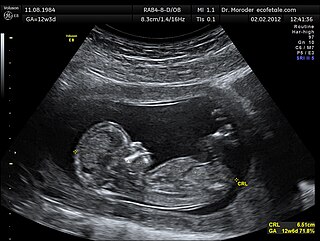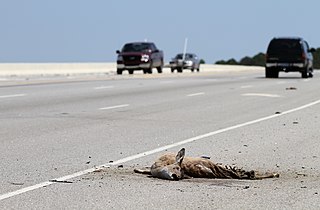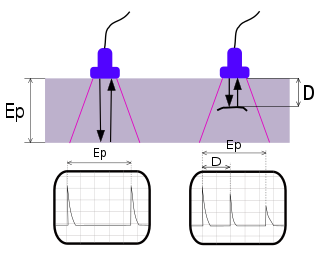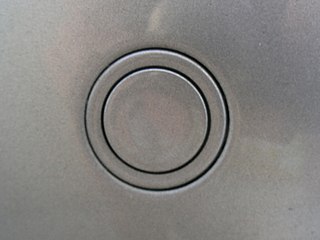Related Research Articles

Ultrasound is sound with frequencies greater than 20 kilohertz. This frequency is the approximate upper audible limit of human hearing in healthy young adults. The physical principles of acoustic waves apply to any frequency range, including ultrasound. Ultrasonic devices operate with frequencies from 20 kHz up to several gigahertz.

Roadkill is an animal or animals that have been struck and killed by drivers of motor vehicles. Wildlife-vehicle collisions (WVC) have increasingly been the topic of academic research to understand the causes, and how it can be mitigated.

A dog whistle is a type of whistle that emits sound in the ultrasonic range, which humans cannot hear but some other animals can, including dogs and domestic cats, and is used in their training. It was invented in 1876 by Francis Galton and is mentioned in his book Inquiries into Human Faculty and Its Development, in which he describes experiments to test the range of frequencies that could be heard by various animals, such as a house cat.

A bumper is a structure attached to or integrated with the front and rear ends of a motor vehicle, to absorb impact in a minor collision, ideally minimizing repair costs. Stiff metal bumpers appeared on automobiles as early as 1904 that had a mainly ornamental function. Numerous developments, improvements in materials and technologies, as well as greater focus on functionality for protecting vehicle components and improving safety have changed bumpers over the years. Bumpers ideally minimize height mismatches between vehicles and protect pedestrians from injury. Regulatory measures have been enacted to reduce vehicle repair costs and, more recently, impact on pedestrians.

Sonic and ultrasonic weapons (USW) are weapons of various types that use sound to injure or incapacitate an opponent. Some sonic weapons make a focused beam of sound or of ultrasound; others produce an area field of sound. As of 2023 military and police forces make some limited use of sonic weapons.

A bullbar or push bumper is a device installed on the front of a vehicle to protect its front from collisions, whether an accidental collision with a large animal in rural roads, or an intentional collision by police with another vehicle. They range considerably in size and form, and are normally composed of welded steel or aluminium tubing, or, more recently, moulded polycarbonate and polyethylene materials. The "bull" in the name refers to cattle, which in rural areas sometimes roam onto rural roads and highways.

Ultrasonic testing (UT) is a family of non-destructive testing techniques based on the propagation of ultrasonic waves in the object or material tested. In most common UT applications, very short ultrasonic pulse-waves with center frequencies ranging from 0.1-15 MHz, and occasionally up to 50 MHz, are transmitted into materials to detect internal flaws or to characterize materials. A common example is ultrasonic thickness measurement, which tests the thickness of the test object, for example, to monitor pipework corrosion.

Hearing range describes the range of frequencies that can be heard by humans or other animals, though it can also refer to the range of levels. The human range is commonly given as 20 to 20,000 Hz, although there is considerable variation between individuals, especially at high frequencies, and a gradual loss of sensitivity to higher frequencies with age is considered normal. Sensitivity also varies with frequency, as shown by equal-loudness contours. Routine investigation for hearing loss usually involves an audiogram which shows threshold levels relative to a normal.

Parking sensors are proximity sensors for road vehicles designed to alert the driver of obstacles while parking. These systems use either electromagnetic or ultrasonic sensors.
Sound from ultrasound is the name given here to the generation of audible sound from modulated ultrasound without using an active receiver. This happens when the modulated ultrasound passes through a nonlinear medium which acts, intentionally or unintentionally, as a demodulator.

Rail inspection is the practice of examining rail tracks for flaws that could lead to catastrophic failures. According to the United States Federal Railroad Administration Office of Safety Analysis, track defects are the second leading cause of accidents on railways in the United States. The leading cause of railway accidents is attributed to human error. The contribution of poor management decisions to rail accidents caused by infrequent or inadequate rail inspection is significant but not reported by the FRA, only the NTSB. Every year, North American railroads spend millions of dollars to inspect the rails for internal and external flaws. Nondestructive testing (NDT) methods are used as preventive measures against track failures and possible derailment.
Electronic pest control is the name given to any of several types of electrically powered devices designed to repel or eliminate pests, usually rodents or insects. Since these devices are not regulated under the Federal Insecticide, Fungicide, and Rodenticide Act in the United States, the EPA does not require the same kind of efficacy testing that it does for chemical pesticides.

Ultrasonic transducers and ultrasonic sensors are devices that generate or sense ultrasound energy. They can be divided into three broad categories: transmitters, receivers and transceivers. Transmitters convert electrical signals into ultrasound, receivers convert ultrasound into electrical signals, and transceivers can both transmit and receive ultrasound.
A cat repeller is a device or substance used to discourage cats from entering an area, or to encourage them to leave if they do enter. Such deterrents are most commonly used by gardeners, in order to prevent damage to their gardens, to avoid cat feces, or to protect birds.

A run-off-road collision is a US term for a type of single-vehicle collision that occurs when a vehicle leaves the roadway.

Hearing, or auditory perception, is the ability to perceive sounds through an organ, such as an ear, by detecting vibrations as periodic changes in the pressure of a surrounding medium. The academic field concerned with hearing is auditory science.
In the field of industrial ultrasonic testing, ultrasonic thickness measurement (UTM) is a method of performing non-destructive measurement (gauging) of the local thickness of a solid element based on the time taken by the ultrasound wave to return to the surface. This type of measurement is typically performed with an ultrasonic thickness gauge.

A horn is a sound-making device that can be equipped to motor vehicles, buses, bicycles, trains, trams, and other types of vehicles. The sound made usually resembles a "honk" or a "beep". The driver uses the horn to warn others of the vehicle's approach or presence, or to call attention to some hazard. Motor vehicles, ships and trains are required by law in some countries to have horns. Like trams, trolley cars and streetcars, bicycles are also legally required to have an audible warning device in many areas, but not universally, and not always a horn.

An ultrasonic toothbrush is an electric toothbrush designed for daily home use that operates by generating ultrasound in order to aid in removing plaque and rendering plaque bacteria harmless. It typically operates on a frequency of 1.6 MHz, which translates to 96,000,000 pulses or 192,000,000 movements per minute. Ultrasound is defined as a series of acoustic pressure waves generated at a frequency beyond human hearing.
Ultrasonic antifouling is a technology that uses high frequency sound (ultrasound) to prevent or reduce biofouling on underwater structures, surfaces, and medium. Ultrasound is just high frequency sound. Ultrasound has the same physical properties as human-audible sound. The method has two primary forms: sub-cavitation intensity and cavitation intensity. Sub-cavitation methods create high frequency vibrations, whilst cavitation methods cause more destructive microscopic pressure changes. Both methods inhibit or prevent biofouling by algae and other single-celled organisms.
References
- ↑ "Deer-Vehicle Collisions are Numerous and Costly. Do Countermeasures Work?". Road Management & Engineering Journal (published May 12, 1997). 1997. Archived from the original on 2006-11-14. Retrieved 2017-07-08.
- ↑ Bender, Helena (2001). "Deterrence of kangaroos from roadways using ultrasonic frequencies - efficacy of the Shu Roo" (PDF). Archived from the original (PDF) on 2010-08-21.